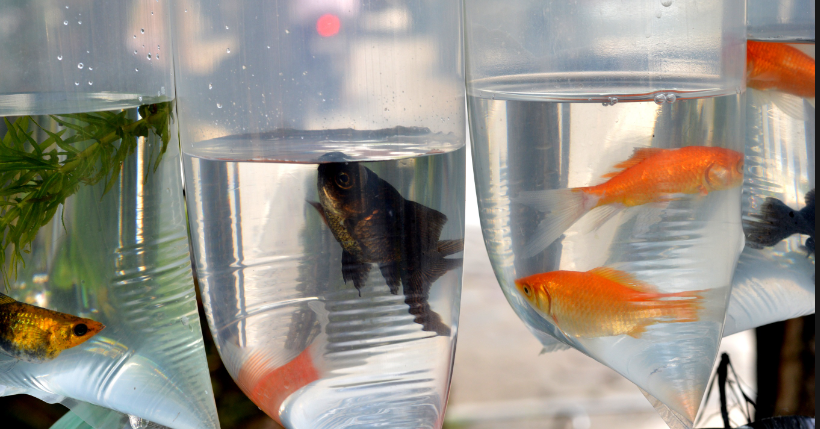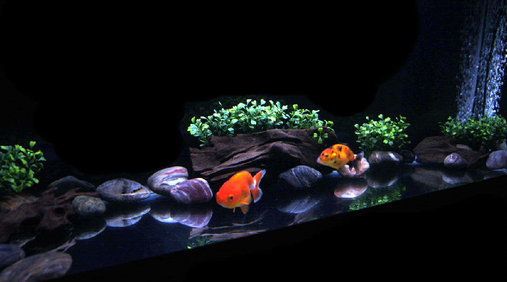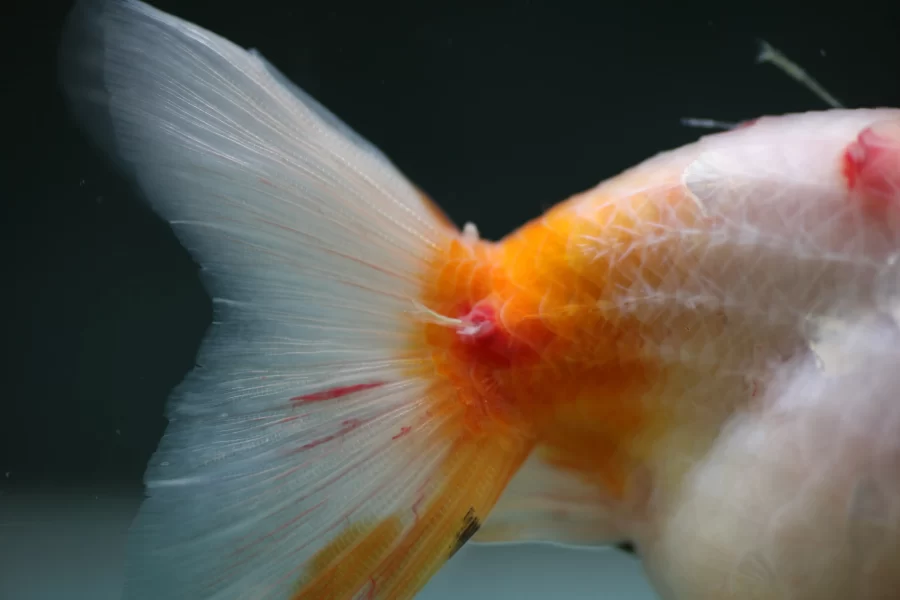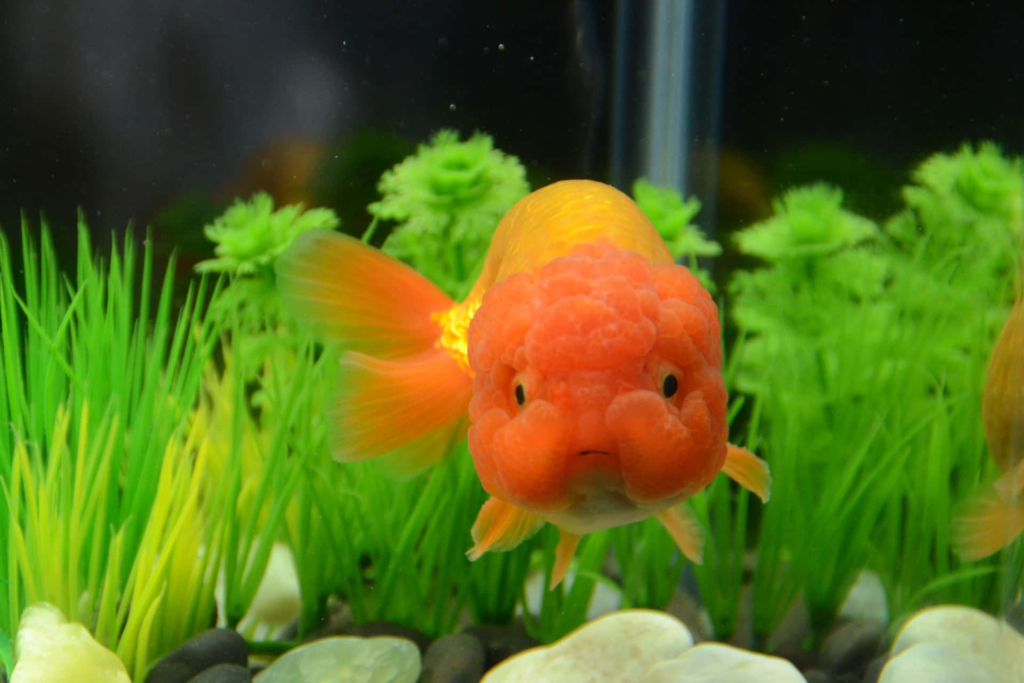
Hello, Goldfish aficionados! Have you ever caught yourself daydreaming about your fish giving you a high five (err… fin-five) because you got its home just right? Well, buckle up because we’re diving into the nitty-gritty of goldfish tank selections! This article doesn’t just have instruction and advice. It has emotion, sprinkled with a pinch of humor as we navigate through your beloved pet’s tank choices.
The Importance of a Proper Tank for Happy Goldfish
Why a Good Tank is Essential for Happy Goldfish

No, your goldfish can’t actually high-five or swim around popping celebratory bubbles. If it does that, you might be in a Disney movie, or the fish food you’re using has magic in it! But, just like how we wouldn’t want to live in a lousy flat with no natural light, your goldfish doesn’t want to live in a tiny bowl with no room to swim. A great home, or tank in this case, is crucial for their happiness and health. It sets the stage for your goldfish’s overall quality of life. Exactly like a stage, if something’s not just right – say a prop is missing or the lighting is too dim – the entire performance can fall flat.
Fish enthusiasts and professionals agree on this – the size, shape, water capacity, filtration system, and location of the tank play a vital role in the health of your swimming buddy. If chosen well, it can mean the difference between your goldfish singing “Under the Sea” or “Part of Your World.”
Avoiding Common Tank-Related Problems
We’ve all been there – the enthusiastic first-time goldfish owners eager to purchase that quirky, spaceship-shaped tank with sparkly lights. I hate to be the bearer of bad news, but these choices can lead to a bunch of issues down the road.
Common problems range from poor water quality and insufficient filtration to stress and disease for your trusty finned friend. But fear not, our guide here will make you the ultimate matchmaker – perfectly pairing your little aquatic friend with their dream home. Now, let’s swim along to the next section where we delve into choosing the right size and shape of the tank. Dive in head-first, or maybe fin-first?
Tank Size and Shape

Understanding the Importance of Tank Size
Contrary to the popular belief (possibly spurred by Dr. Seuss’ “One Fish, Two Fish, Red Fish, Blue Fish”), goldfish do not belong in teeny-tiny bowls. Goldfish are quite the Michael Phelps of the fish world – they love space and, importantly, they need it to thrive. Large tanks offer more surface area for oxygen exchange, crucial for their well-being.
Sizing, to your surprise, also affects how large your goldfish can grow. It isn’t like those magical shrinking machines from sci-fi movies, but confined small spaces can indeed stunt goldfish growth. Consider this: you wouldn’t like to live in a shoebox, so why would a goldfish? For a happy aquatic amigo, aim for a minimum tank size of 20 gallons for one goldfish, and 10 additional gallons for each added lucky fin.
But don’t start measuring that aquarium for an Olympic-sized pool-sized upgrade just yet. Size is important, but the shape of the tank matters too.
Choosing the Right Tank Shape for Your Space

Choosing a tank is a bit like a game of Tetris. You need the right shape to fit your space, without cramming your living room with a clunky cube, or settling for a flimsy flat-back hex. But remember, this isn’t just a décor decision – it affects your goldfish’s home sweet home and health.
Long, rectangular tanks work best for our golden buddies as it gives them ample swimming room and maximizes the surface area for oxygen. Bowfront tanks may charm you with their panoramic view, but the distorted view might stress your dear fish. Depth is secondary to surface area, so skyscraper-like tanks aren’t the best deal either!
After all, coordinating the tank with your living space, while ensuring it’s a goldfish paradise, is almost as crucial as pairing the right wine with your cheese — one delights your senses, the other delights your fish (sans wine, of course). Now, enough about the structure. Let’s crack the da Vinci code on water capacity and filtration in the next section.
Water Capacity and Filtration

Finding the perfect space for fishy friends to swim around in can feel like finding a needle in a haystack. Water capacity and filtration are two of the elements that significantly contribute to the health and happiness of your goldfish, and if you’ve ever seen the surprised face of a goldfish – yes, they can look surprised – you would want to avoid it at all costs.
Determining the Ideal Water Capacity for Goldfish
Goldfish are not exactly the Michael Phelpses of the fish world, but they do need enough space to stretch their fins comfortably.
It’s a common misconception that goldfish can happily live in small bowls; this is about as accurate as saying humans can comfortably live in telephone booths – I’m looking at you, Clark Kent. In reality, these social swimmers need around 20 gallons of water for one goldfish, and an additional 10 gallons for each friend they share their underwater city with. This ensures they have ample water to keep them healthy and active. Remember, a happy fish equals a happy owner; it’s a therapy that doesn’t require a couch!
Exploring Different Filtration Options
Now that we know how much water our aquatic athletes need, let’s chat about how to keep that water crystal clear. Your goldfish could have an abundant water wonderland, but it still needs to be clean. This is the underwater equivalent of having fresh sheets on the bed; it’s a game-changer!
There are several filtration systems to peruse; internal, external, undergravel, and sponge filters, which sound like exotic smoothie names more than anything else, right? But hold the Strawberries & Cream! Each system has pros and cons, and your choice should rely on your specific tank setup. Internal and sponge filters are great for low current and betta fish. External filters work with larger tanks, and under gravel filters are an aesthetic and functional choice for hobbyists. A good filtration system is as essential to a tank as salsa is to a chip; it adds the zest needed for a crisp, clean fish home.
Up next, we’ll talk about tank materials and construction (I promise no boring building codes!). We’ll delve into the differences between glass and acrylic tanks, and how to make sure your fish mansion is as sturdy as Fort Knox. We’re also going to look into sealants, which are usually as unknown to people as the final digits of Pi, but are crucial in the world of aquariums. Stay tuned!
Tank Materials and Construction
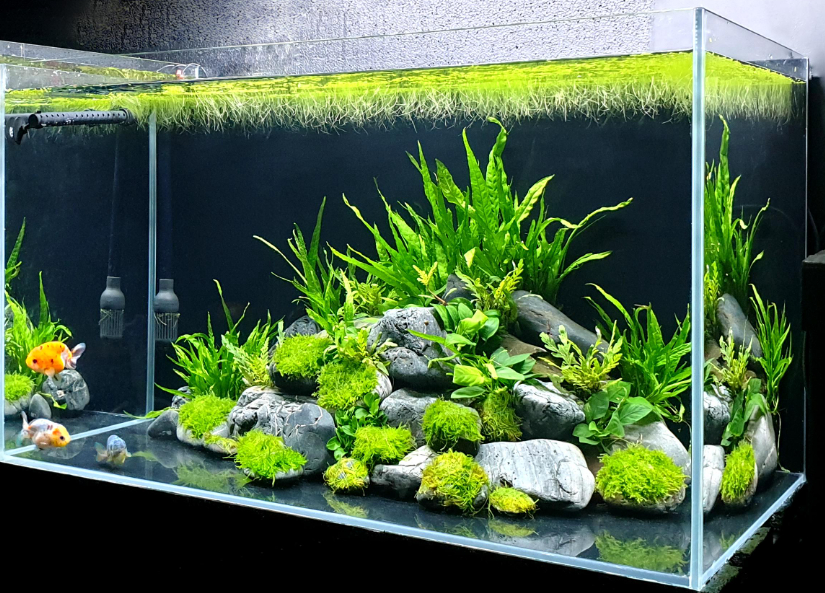
Choosing the correct tank material might feel like picking out a new pair of glasses. Do you want something heavy and durable, like glass, or something lightweight and potentially more durable, like acrylic? Let’s dive into this!
Comparing Glass and Acrylic Tanks
Both glass and acrylic tanks have their virtues and downfalls. Your traditional glass tank may feel more robust, and I guarantee it to be a champ when it comes to resisting scratches. It’s kind of like the ‘grandma’ of tanks – timeless and reliable. But hey, don’t let it fool you. If you drop a heavy object or decide to give it a tap dance routine, it’ll quit on you quicker than you can say “I think I’ve made a mis-fin-stake!”
On the flipper side, acrylic tanks are the newcomers in the aquarium industry, ready to challenge the status quo. They’re lighter than glass and have better insulation properties, which means it retains heat more effectively. And the best part? Acrylic tanks can actually take one heck of a beating! They won’t quit on you if you accidentally bump into it, but be careful around it with sharp objects as they scratch easily. Yes, it shares a trait or two with a melodramatic lovesick teenager.
Checking for Sturdy Construction and Reliable Sealant
Once you’ve decided on the material, it’s time to check the construction of the tank. Tanks with corners? Yes, please! Your goldfish would love a good nosy poke into corners. Also, make sure there are no sharp edges as you don’t want your goldfish impersonating a knife-thrower’s assistant.
The next crucial element is the tank’s sealant. Think of it as the glue that holds your goldfish’s world together. The sealant should appear neat and uniform. You don’t want a crusty, old, dried up one. Pro tip: Clear silicone seal is the queen bee, get that one!
Our tank materials and construction voyage comes to an end here, but don’t change your diving suit yet. The deep sea of knowledge beckons us to the next section, where we’ll be tackling a topic that’s sure to light up your interest – lighting and decorations. Hang on tight folks; we are about to turn the brightness up a notch!
Lighting and Decorations
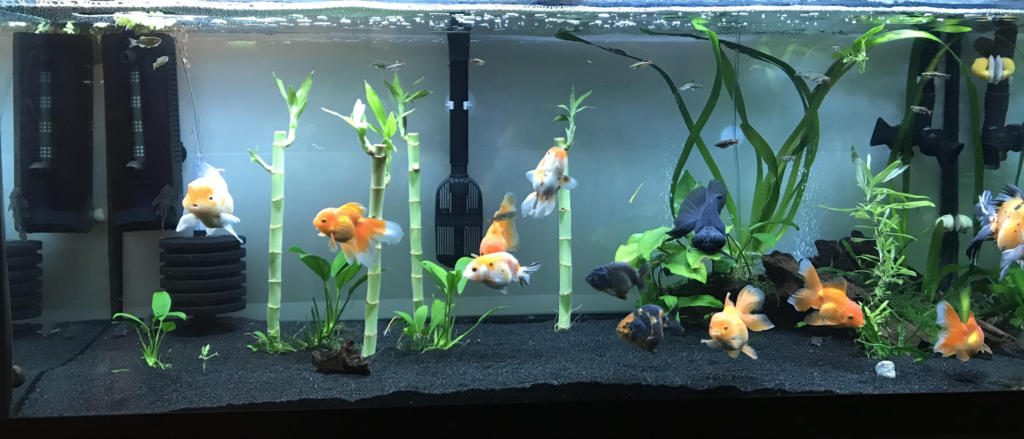
Nothing jazzes up your goldfish tank like a bit of twinkle and spangle, right? Absolutely! But hold on, before you bring out those disco ball lights and LED strips from last Christmas, let’s clear the water on a crucial piece of information: Goldfish need light… just not too much of it!
Providing Appropriate Lighting for Goldfish
It’s true. Despite their nonchalant, carefree swimming and lack of sunglasses, goldfish also need their fair share of light and darkness. Why? Because much like us, they have sleep cycles that dictate their circadian rhythm. Picture this: your goldfish cruising around the tank aimlessly at 3 AM, with a grand illuminating backdrop. Seems like a fishy version of “Sleepless in Seattle,” doesn’t it?
But how much is too much? About 8-12 hours of light per day is just about perfect for these fin-tastic creatures. Any more, and you risk damaging their scales and encouraging the growth of undesirable algae.
There are numerous lighting options you could use. Fluorescent lights, for instance, are energy-efficient and provide an excellent spectrum of light for the fish. LEDs, on the other hand, consume even less energy and give you the ability to control the intensity and color of the light. Remember, steady and natural light is what your goldfish appreciate, not strobe or revolving party lights.
After that enlightening bit on lighting (pun very much intended), we swim on over to the visually appealing element of tank-keeping: decorations!
Choosing Safe and Engaging Tank Decorations
Who doesn’t love a good tank decor? It’s like creating a reality TV set for your goldfish. However, let’s not confuse the tank with an episode of “Pimp My Tank”. Less is more when it comes to decorating your fish’s humble abode. After all, we’re preparing a suburb for your goldfish, not a bustling city.
Decorate, but be mindful of the space that your fish needs to swim around comfortably. It’s also important to stick to smooth decorations, as sharp edges might injure your goldfish. You can choose from rocks, plants (live or artificial), or even castles; all are fair game, as long as they are made from fish-safe materials.
Avoid metallic decorations, as they might rust over time and negatively influence the water chemistry. Remember, safety first. We don’t want your fish to turn into the Nemo remake no one asked for.
Congratulations, you’re officially a “fin-tastic” decorator! But don’t drop the net just yet, up next, we’re diving into a topic that’s crucial for your goldfish’s long-term health and tank cleanliness: Maintenance and Cleaning. Keep swimming!
Maintenance and Cleaning

Goldfish might be cute and unassuming, but let’s face it, they’re not winning the award for most hygienic pets any time soon. Any fish, no matter how charismatic it wiggles, is a master transformer—morphing wonderfully pure water into a cocktail of fish food and fish… uh, let’s call it ‘output’.
Establishing a Regular Cleaning Routine
It’s tempting to procrastinate tank cleaning (can a dirty tank be that harmful?). Believe me, it can. A clean tank should be a non-negotiable if you want your gilled pal happy, healthy, and not longing for a greener aquarium. Implement a regular cleaning routine; once a week is a pretty good rhythm that even the busiest of us can march to. Start with changing about 25% of the tank’s water. Use a siphon to vacuum out all the debris from the gravel. Yeah, it’s a bit like cleaning under your couch, only wetter.
Next, give the glass, décor and filter a gentle scrub. You’ll be amazed (and possibly disgusted) at what comes off. Just remember to save the cleaning of your filter until last, and always rinse it in the tank water you removed earlier to protect any beneficial bacteria. It might seem like a lot, but once you get into the groove, it’s all smooth sailing—er, swimming?
Using Safe and Effective Cleaning Products
Alright, down to the nitty-gritty: cleaning products. Despite what your friend’s cousin’s mom might have told you, using your regular household cleaners is a big no-no. Strong chemicals can play a lethal game with your goldfish’s health.
Instead, pick up some cleaners that are designed specifically for aquariums. These products know how to power through the grime without pulling a Thanos on your fish population. And remember the trusty old scrubbing brush? Get one exclusively for the tank. Mixing up tank tools with kitchen tools must be avoided unless you fancy a hint of algae with your spaghetti.
Even with these fancy tools, the most important cleaning agent is none other than H2O. A clean water source, free from chlorine and heavy metals, is your goldfish’s first defense against a dirty tank. Sometimes, the old ways are the best ways.
Before you even realize it, we’ve ended our dip into the world of tank maintenance and cleaning. Can you feel the freshness? Better yet, can you see it reflected in your now gleaming goldfish tank? Coming up, we’re turning our fishy focus to something less physical, but equally essential—temperature and heating. Put on your science hats folks, we’re about to dive deep!
Temperature and Heating
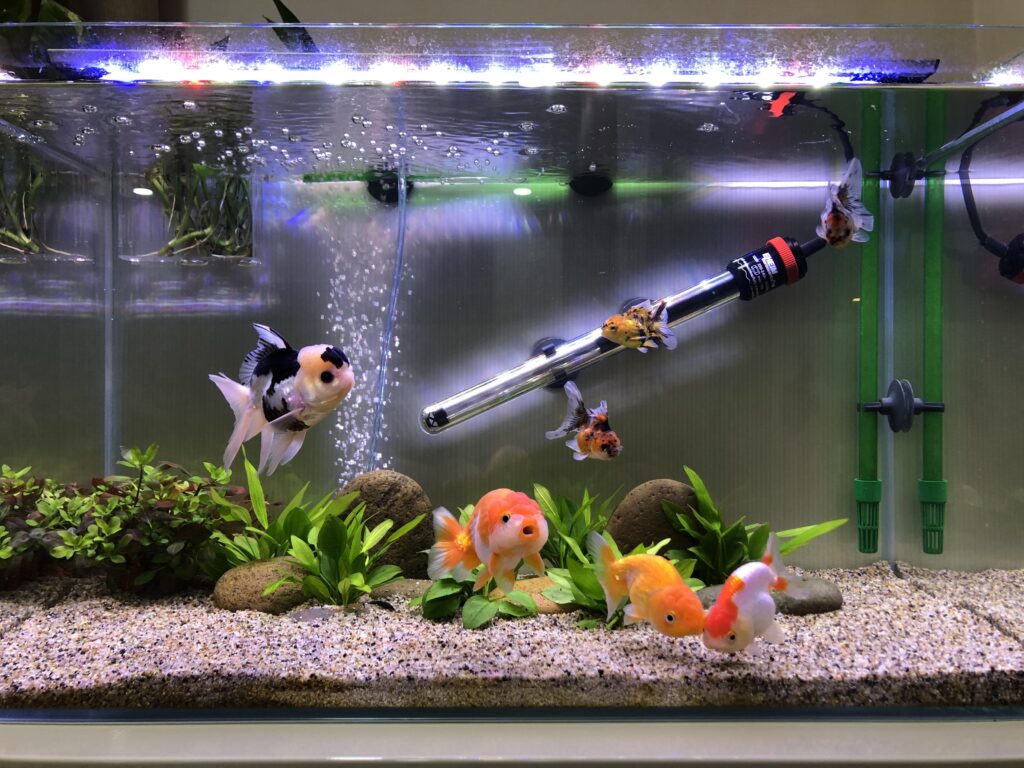
Just telling you, for a goldfish, their tank is more than just a home—it’s their catwalk, their luxury suite, and their personal spa. I mean, who wouldn’t want a life like that?! By managing the right temperature, you provide them all the comforts they need (or in goldfish talk: they need-need), while keeping them fab and fancy.
Maintaining Optimal Water Temperature
Think about your ideal vacation. Is it on a tropical island or a snowy mountain peak? Now remember, we are not talking about your preferences, but what your goldfish would find most comfortable (Hint: It’s not the snow!).
Goldfish are cold-water fish and prefer temperatures between 65-72°F (18-22°C). That’s your Spring and Autumn weather, my friend. Too hot or too cold can send them into shock, and trust me, no shocked faces look good in a classy tank.
Just like taking your temperature when you’re not feeling your best, regularly checking the water temperature is important. For this, get yourself an aquarium thermometer. They don’t require any elbow-grease at all! Stick them on, and voila – you’re the weather man of your goldfish world.
Now, I know what you’re thinking: “Oh no! The temperature went beyond the limit. What do I do?” Well, let me introduce you to some pretty cool gizmos called aquarium heaters, which brings us to our next point.
Exploring Reliable Heating Options
Okay so we’ve established that maintaining a consistent temperature helps keep your buttery companion healthy and cheerful. But what about when the apartment gets chilly, and you start wearing socks to bed, but your goldfish can’t do that? This is where aquarium heaters come into play.
Contrary to their name, these can also help cool the water when it’s too hot. They’re basically a climate control for your goldfish. When looking for a heater, pick one that accurately maintains the temperature within the desired range. Make sure to select the right wattage based on your tank size. A rule of thumb is 5 watts per gallon of water.
So, with your temperature fashionably sorted, fasten your seatbelt as we unfold yet another crucial aspect of the goldfish world – The Oxygen Fiesta!
Air and Oxygenation

Here’s a little secret from the land of gills and fins- goldfish are total air heads. No, not in the ditzy sense. They enjoy their O2, and boy do they need it! Exploring now, how to keep your goldfish from gasping “I can’t breathe!”
Ensuring Proper Air Circulation in The Tank
All living things demand oxygen and your little finned friends are no exception. Though fervently living under the water, they breathe the oxygen present in it. Sounds like a magic trick? It’s pure science!
Maintaining proper air circulation is invariably crucial for your goldfish’s survival. Stagnant water can result in the oxygen level dropping too low, leaving your goldfish gasping unseen at the surface. Once you’ve thrown in your fishy friends, watch out for them gasping at the upper surface of the water— if more than usual, it may mean trouble.
So how can you keep the H2O in your tank properly oxygenated? Stirring up the surface by adjustable water flow, placing your water pump up where it can disrupt the surface, and regular cleaning practices will work great tricks!
Pssst! Now onto a secret hint from the depths of the goldfish tank. While your goldfish would survive in a moderately oxygenated environment, thriving comes from tanks that seem to have their own breezy circulation. So here’s a crisp transition – Let’s plunge into the unexpected world of… oxygenation devices!
Adding Oxygenation Devices if Needed
As loving pet-parents, sometimes, we need to put on our tech caps. You might notice that simple water stirring methods aren’t quite cutting it. In this case, your goldfish are essentially miming to you, “We need more O2, please!” That’s your cue to incorporate an oxygenation device into your goldfish tank.
Device what? Picture an air pump or air stone crafting beautiful, fish-friendly bubbles that enhance the tank’s oxygen content. Not only will your fish thank you with their swift, energetic swooshes and reduced gasping, but it adds a decorative element to the tank. Who knew oxygen could be so aesthetic?
And voila! Now you’re not only a goldfish parent but an air quality manager, too! Fancy titles and happy goldfish? What a deal.
In our ongoing trip down fishtown, we dealt with air and oxygenation- critical to your fish child’s health and hustle. Now that we’ve blown bubbles and added invisible, all-important oxygen, where’s the next turn? As our goldfish swim gleefully in their well-oxygenated abode, let’s turn our discussion to where this lovely new home should sit in your space, in our upcoming section, Tank Placement. Stay tuned!
Tank Placement and Environment

Ah, location, location, location! We’re not talking real estate here but tank estate where your goldfish will be spending their days, preferably not on the kitchen counter where it ends up splashed with pancake batter every Sunday. Much like the right backpack for school or the perfect pocket for a favorite fidget spinner, yes, where you place the fish tank matters.
Finding the Right Spot for Your Goldfish Tank
Firstly, position your tank away from direct sunlight; we don’t want to roast our water buddies. It’s important to note that fish tanks aren’t decorative art pieces. A spot near a heater or in the trajectory of your air conditioner’s arctic blast is also a no-no; it’s a subtle science of temperature control.
Avoid high-traffic and noisy areas too; Cousin Keith’s heavy metal band schedule should be taken into account. While your goldfish may not directly complain (their complaints are mostly bubbles), sudden vibrations can stress them out. High shelves or wobbly tables have all the makings of a disaster movie, starring your goldfish. So, choose a stable, quiet, temperature-consistent location. Trust us, your goldfish will appreciate it.
As we wave goodbye to the subject of tank placement, let’s turn our fins to the next important point – creating a conducive environment for your new pet.
Creating a Conducive Environment for Your Goldfish

In the wild, goldfish are river creatures, enjoying pockets of calm in the aquatic hustle. Recreate this calmness with plenty of hiding spots using aquatic plants, caves, or decorations, so they can play hide and seek (Yes, they do that!).
Remember to leave enough swimming space though! Too much bling can cramp their style. Monitor your goldfish behavior; if they seem distressed, adjust the environment until you find the right balance—like removing that awkwardly shaped Titanic replica that looked awesome but keeps getting in the way.
Natural light cycles are also important, replicate them using aquarium lights. Be Goldilocks about this – not too bright and not too dark!
Having constructed this ideal fish castle, make sure it’s clean too. Contaminants can cause health issues and reduce lifespan. Regular maintenance is key.
And just like that, we’ve created a Zen-like environment for our aquatic buddies, touching on the importance of calm, clean, and comfortable surroundings.
In the marathon of aquarium setup, the last lap awaits us – the conclusion – where we sum up everything we’ve learned so far, underscore the importance of choosing the right tank, and affirm our commitment to creating a healthy and happy home for your goldfish. Let’s swim towards it!
Wrap Up
Taking the Time to Choose the Right Tank Pays Off
And there you have it, Spartacus! (Oh, you didn’t name your goldfish Spartacus yet? Nevermind, then) Foolproof and effective tips in choosing the perfect aquarium for your soon-to-be aquatic companion. Remember, you’ll want your fish to have the comfort and freedom of the Atlantic in a tank the size of a treasure chest. Trust us, your deep-sea dwellers, goldfish in this case, will thank you.
Everything from the tank’s size, shape, and used material to the small things like heater, filters, and decorations adds up. Now it may sound like you’re designing a bachelor pad for George Clooney. But in reality, it’s less about aesthetics and more about ensuring your goldfish get their much-deserved R&R. If you thought you were meticulous about home decor, wait till you feel the satisfaction of creating a suitable living environment for your goldfish.
Ensuring a Happy and Healthy Home for Your Goldfish
So, as we plunge to the end of our goldfish journey, remember that your seaside pet, just like any other, needs love, care, and a suitable environment to thrive in. All you fin-tastic parents, (get it? Fantastic…fin-tastic…never mind), it’s not just about getting the fanciest tank or the glitziest pebbles, it’s about understanding what your fish needs.
Just like any proud house owner, you’re going to want to show off your newly minted goldfish setup. But remember, while it will make a great conversation starter at your next dinner party, it’s a home for your pet.
The right tank can make a world of difference to your goldfish, ensuring they live long, happy, and healthy lives. And isn’t that the ultimate reason why we decided to get a pet in the first place? For the joy, they bring into our lives? So, do right by your new Goldie Hawn, and you’ve ensured a budding friendship that lasts a lifetime!
So next time you see a goldfish in a small bowl, unleash your inner Aquaman (or mermaid, we don’t judge) and spread the gospel – goldfish need space, care, and the right tank mates to truly shine!
Your goldfish might not write you a heartfelt thank-you note, but the way they joyfully circumnavigate their new luxurious dwelling will be thanks enough. Let’s embark on this fantastical adventure of fish parenting together.
Frequently Asked Questions (FAQ)
Question 1: What is the ideal size for a goldfish tank?
Answer: The rule of thumb is for every inch of fish, you’ll need 1 gallon of water. So, your average goldfish (which usually grows up to 6-8 inches for fancy varieties or 12 inches for single-tails) will need a tank of at least 20-30 gallons.
Question 2: What shape of the tank should I choose?
Answer: Rectangle-shaped tanks are ideal as they offer the most swimming space and have the largest surface area for oxygen exchange, which is vital for your goldfish.
Question 3: How often should I change the water and what kind of filtration do I need?
Answer: You should change 10-20% of the tank water weekly. For filtration, go for filters that provide both mechanical and biological filtration.
Question 4: Glass or acrylic tanks – which is better?
Answer: Both have their pros and cons. Glass tanks are harder to scratch but are heavier and can shatter. Acrylic tanks are lighter and more impact-resistant but scratch easily.
Question 5: How should I light my goldfish tank and what decorations are safe?
Answer: Optimal lighting is important for your goldfish’s well-being. Too much light can lead to algae growth so aim for 8-12 hours of light per day. Use only aquarium-safe decorations that have no sharp edges.
Question 6: How frequently should I clean my goldfish tank?
Answer: Aim to clean the tank thoroughly once a week. However, daily checks for uneaten food, decaying plants, and sickness symptoms are recommended.
Question 7: What’s the ideal temperature for a goldfish tank?
Answer: Goldfish thrive at temperatures between 20°C (68°F) and 23°C (74°F). A reliable heater can help stabilize water temperature.
Question 8: Do I need to oxygenate my tank and how?
Answer: Yes! Goldfish need well-oxygenated water. You can oxygenate your tank by having a good filtration system and possibly adding an air stone.
Question 9: Where should I place my goldfish tank?
Answer: Ideally, place it away from direct sunlight, drafts, heating, or air conditioning vents. Choose a low-traffic area to reduce stress on your goldfish.
Question 10: How can I create a conducive environment for my goldfish?
Answer: Apart from maintaining correct temperature and oxygen levels, providing a balanced diet and minimizing stress by controlling light exposure and noise will create an ideal environment.

